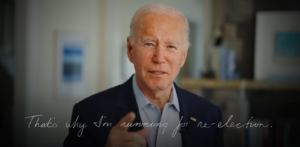 The time for ‘Will Biden Run in 2024?’ think pieces is over, now begins the era of ‘How is Biden’s 2024 Campaign Going?’ think pieces.
The time for ‘Will Biden Run in 2024?’ think pieces is over, now begins the era of ‘How is Biden’s 2024 Campaign Going?’ think pieces.
On April 25th, four years to the day after he kicked off his 2020 campaign, President Biden officially launched his 2024 campaign. As he did in 2019, Biden made this announcement via video, with a message centered around Charlottesville and his contention that we were in a “battle for the soul of this nation”.
Four years later, Biden is still highlighting alt-right violence, opening this new video with footage of the January 6th insurrection before pivoting to his message for 2024.
“Freedom,” Biden begins. “Personal freedom is fundamental to who we are as Americans. That’s been the work of my first term, to fight for our democracy.”
The President then attacks “MAGA extremists [who] are lining up to take on those bedrock freedoms”; as Biden goes on to cite GOP policy proposals concerning Social Security, tax cuts, abortion, book bans, LGBT rights and voting rights. Not coincidentally that message is broad enough to encompass both Donald Trump and Ron DeSantis, the two leading Republican candidates, who are both shown when Biden first mentions “MAGA extremists”.
Furthermore, in a 90-second TV ad released a day later by the DNC, the Biden team doubles down on this freedom and democracy theme.
“Joe Biden has made defending our basic freedoms the cause of his Presidency,” the narrator asserts. “Joe Biden is running for re-election to make certain that the Sun will not set on this flag. The promise of American democracy will not break.”
Biden’s 2020 pollster Celinda Lake told New York Magazine’s Gabriel Debendetti that this freedom message serves a dual purpose. On the one hand, it works as a personal freedom message to Biden’s base of women concerned about abortion access. At the same time, it also works as an economic freedom message to Latino men, a group that Biden needs yet has struggled with.
This focus on freedom sounds similar to the closing message used by Josh Shapiro last year during his successful run in the Pennsylvania Gubernatorial race. Shapiro pulled off a pit of political jiu-jitsu by turning Republican nominee Doug Mastriano’s freedom message against him. In fact, this riff was the centerpiece of an address Shapiro gave at a November 5th Philadelphia rally alongside Biden.
Nor would it be the first time Biden adopted a campaign message from someone else. After all, the concept of a “battle for the soul of the nation” came from historian and occasional Biden speechwriter Jon Meacham.
Meanwhile, another recurring phrase in these opening spots was “Let’s finish the job”. If you remember, this exhortation appeared twelve times in Biden’s last State of the Union Address, so it’s clearly a favorite of the Biden Administration’s. On top of that, it was also a slogan for FDR’s successful re-election effort in 1944.
Speaking of which, how does Biden’s declaration compare to other announcements from incumbent Presidents? Despite what you may have assumed, these campaign kickoffs are usually quite lackluster. For example, they typically eschew any sort of major rally until much later in the process.
In recent years, Presidents usually only declare this far out so they can begin to fundraise. Back in 1995, that meant sending physical letters requesting donations to the mailboxes of a million Democrats. Nowadays, of course, such transactions can be done with a simple click and there’s seemingly no limit to how many emails can be stuffed into our digital inboxes.
So just how much should Biden be aiming to bring in between now and the end of the fiscal quarter on June 30th? Well, I dug into FEC reports to see what past incumbents were able to raise during their first fundraising quarter (in terms of total contributions):
Since Donald Trump first filed for re-election on his first day in office, there’s not really a good comparison. Historically, though, incumbent Presidents used to announce in the fourth quarter of their third year, as Carter, Reagan and Bush 41 all did. Bill Clinton moved that timeline up to the second quarter, which every President since (except Trump) has followed.
As you can see, the post-FEC fundraising totals took a jump in the 1990s before an even bigger bump in the 2000s. To get off on the best possible foot, Biden will seek to surpass those impressive numbers put up by Bush and Obama.
This, of course, will be only the first of many benchmarks Biden will try to hit in this 2024 race.